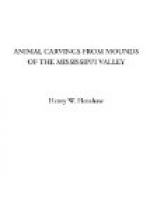a “peculiar significance” (Short) attached
to this side of the tablet. In Short’s
engraving, while the front side corresponds closely
with the same view given by Squier and Davis, there
is a notable difference observable on the reverse
side. For the formless depression of the Squier
and Davis cut not only occupies a somewhat different
position in relation to the top and sides of the tablet,
but, as will be seen by reference to the figure, it
assumes a distinct form, having in some mysterious
way been metamorphosed into a figure which oddly enough
suggests the manatee. It does not appear that
the attention of archaeologists has ever been directed
to the fact that such a resemblance exists; nor indeed
is the resemblance sufficiently close to justify calling
it a veritable manatee. But with the aid of a
little imagination it may in a rude way suggest that
animal, its earless head and the flipper being the
most striking, in fact the only, point of likeness.
Conceding that the figure as given by Short affords
a rude hint of the manatee, the question is how to
account for its presence on this the latest representation
of the tablet which, according to Short, Mr. Guest,
its owner, pronounces “the first correct representations
of the stone.” The cast of this tablet
in the Smithsonian Institution agrees more closely
with Short’s representation in respect to the
details mentioned than with that given in the “Ancient
Monuments.” Nevertheless, if this cast
be accepted as the faithful copy of the original it
has been supposed to be, the engraving in Short’s
volume is subject to criticism. In the cast the
outline of the figure, while better defined than Squier
and Davis represent it to be, is still very indefinite,
the outline not only being broken into, but being in
places, especially toward the head, indistinguishable
from the surface of the tablet into which it insensibly
grades. In the view as found in Short there is
none of this irregularity and indefiniteness of outline,
the figure being perfect and standing out clearly
as though just from the sculptor’s hand.
As perhaps on the whole the nearest approach to the
form of a manatee appearing on any object claimed to
have originated at the hands of the Mound-Builders,
and from the fact that artists have interpreted its
outline so differently, this figure, given by the
latest commentators on the Cincinnati tablet, is interesting,
and has seemed worthy of mention. As, however,
the authenticity of the tablet itself is not above
suspicion, but, on the contrary, is believed by many
archaeologists to admit of grave doubts, the subject
need not be pursued further here.
[Illustration: Fig. 13.—Cincinnati Tablet. (Back.) From Short.]
TOUCAN.
The a priori probability that the toucan was known to the Mound-Builders is, of course, much less than that the manatee was, since no species of toucan occurs farther north than Southern Mexico. Its distant habitat also militates against the idea that the Mound-Builders could have acquired a knowledge of the bird from intercourse with southern tribes, or that they received the supposed toucan pipes by way of trade. Without discussing the several theories to which the toucan pipes have given rise, let us first examine the evidence offered as to the presence in the mounds of sculptures of the toucan.




